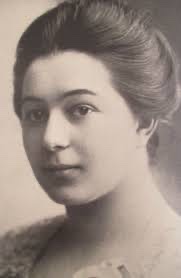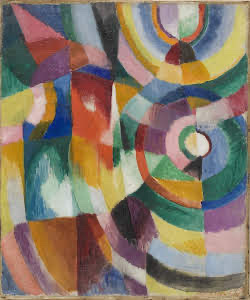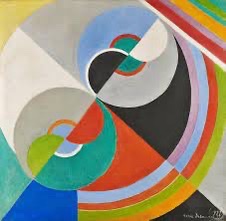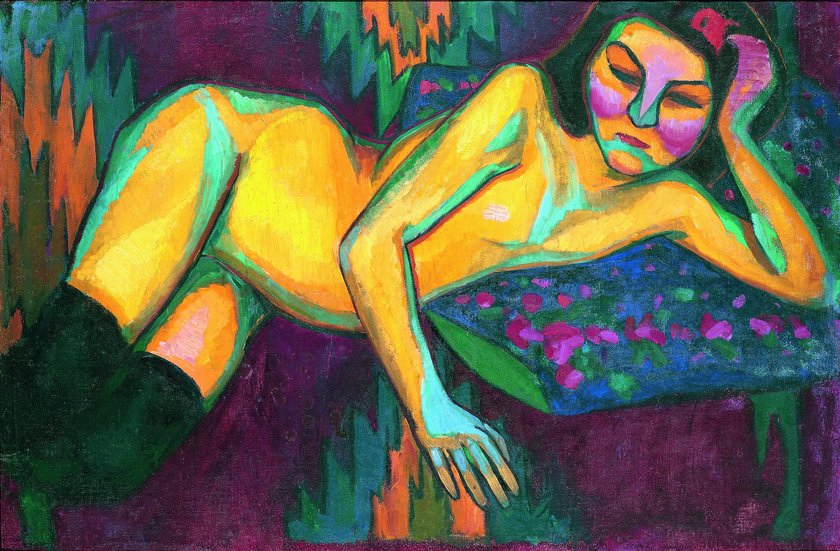
Sonia Delaunay is a Ukrainian artist who mainly worked in the Parisian Avante-Garde scene, after studying all over Europe. At a young age, Delaunay moved to St.Petersburg with her uncle’s family who gave her a well-educated life even though she missed her life in Ukraine. As she grew older she was pressured by her family to stop pursuing art and to get married, this lead her to marry her first husband who was a queer close friend so they helped each other out so they could each keep doing what they loved while still fitting into society. They eventually divorced and Sonia married her second husband Robert, who I think was her creative and intellectual equal which is why they made such a fitting couple. Even after their separation Sonia and her first husband stayed lifelong friends.
As an artist, Sonia is a part of the modern art movement and Orphism. Her husband, Robert, and herself are also was the driving force behind Stimulatism which is a branch of Orphism. Stimulatism is a movement associated with how colours look different depending on other colours placed beside them. For example, yellow looks more saturated beside a purple hue than a brown hue. The Delaunay’s used this method to make different vibrant overlapping hues encourage movement and depth, creating work that was visually compatible and exhibited together often. Truly an Avante-Garde power couple. The idea made a huge impact on the impressionists, post-impressionists, and neo-impressionists in the 1900s.


Her work focuses on colour and abstract movement incorporating a lot of asymmetrical but balanced elements into her paintings. I think that a work that encapsulates this perfectly is “prismes electriques” ca. 1914 in oil on canvas. The painting features a variety of abstract overlapping shapes and spheres in all different tones and has since been acknowledged as her trademark style. Instead of replicating the view of a place or person, I think Delaunay prefers to represent the energy and light of her muses. Some of her other famous paintings are “Rythme Couleur”, “Market at Minho” and “Sleeping Girl” which is a good example of how Delaunay captures the vibrant colours within her portrait paintings. Another abstract portrait painting by her “Nu Jaune” ca. 1908 displays her vibrant use of colour within portraiture and the portrait itself doesn’t try romanticism the models’ beauty in any way.


“Colour is the skin of the world” – Sonia Delaunay
Sources
“Sonia Delaunay: the Avant-garde Queen of Loud, Wearable Art.” The Guardian, 22 Feb. 2018, www.theguardian.com/artanddesign/2015/mar/27/sonia-delaunay-avant-garde-queen-art-fashion-vibrant-tate-modern. Accessed 19 Nov. 2021.
“Sonia Delaunay.” www.artnet.com/artists/sonia-delaunay-terk/. Accessed 19 Nov. 2021.
Tate. “Who is Sonia Delaunay?” Tate, www.tate.org.uk/whats-on/tate-modern/exhibition/ey-exhibition-sonia-delaunay/delaunay-introduction. Accessed 19 Nov. 2021.
“Orphism – Art Term.” Tate, www.tate.org.uk/art/art-terms/o/orphism. Accessed 19 Nov. 2021.
December 6, 2021 at 9:24 pm
Lauren,
Nice work on Sonia Delaunay here! Good information combined with solid analysis and personal thoughts thrown in! I did not know much about here so thanks for the introduction. I’m giving you a 2/2 for this latest post.
You’ll get the chance to deliver your PK presentation on Wednesday morning.
Jeff